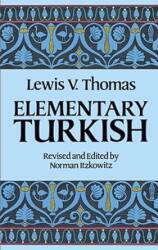
Basics of Turkish Grammar
Word Order in Turkish Sentences
It is good to know that whenever you're feeling too full of yourself, you can always do something simple to take yourself down a notch or two. Maybe something so simple, or really not so simple, as reading and trying to understand something like Robert's Underhill's paper "Turkish Participles", from Linguistic Inquiry, vol 3, no 1 (Winter 1972), pp 87-99.
Yes, sentences generally take the form: Subject object(s) verb, so something like:
| Turkish: | Köpek | suyu | içiyor. |
| English: | (The) dog | (the) water | is drinking. |
The word immediately before the verb is (usually) the most important word in the sentence and conveys the main point, or so Lewis tells us. The subject is often left out if it is a personal pronoun, since it can be derived from the verb conjugation.
That's the general form of things, but by no means does it tell the whole story. And Underhill mentions that the form described in the standard grammars is not what his native-speaking Turks tell him is the usual form.
According to Underhill, the most neutral or "unmarked" order
of a Turkish sentence is:
subject, direct object, indirect object, verb.
Grammars like Lewis' and others reverse the direct and
indirect objects.
Changing the specific words of Underhill's examples, let's
say we wanted to render the sentence
The boy threw the ball to the dog in Turkish:
Oğlan topu köpeğe attı.
The-boy the-ball to-the-dog threw.
subject direct-object indirect-object verb.
| oğlan | boy in nominative case |
| topu | ball in accusative case: top - u —> topu |
| köpeğe | dog in dative case: köpek - e —> köpeğe |
| attı | to throw, atmak in past tense |

The Sultanahmet Cami (Blue Mosque) in İstanbul. See my travel pages for many more pictures.
Now, that's fine if you're being definite about everything: The boy threw the ball to the dog. But now let's say that we're being vague about the direct object — the boy didn't throw the specific ball we were discussing earlier, he threw a ball, or even some balls. In that case the direct object moves to just before the verb and loses its accusative (or objective) suffix:
Oğlan köpeğe top attı.
The-boy to-the-dog a-ball threw.
subject indirect-object indefinite-direct-object verb.
Now let's say that it's the subject that's indefinite — it wasn't the boy we were discussing, but a boy or some boy. In this case it's the subject that moves to just before the verb, and it picks up bir or one to mean a:
Topu köpeğe bir oğlan attı.
The-ball to-the-dog a-boy threw.
direct-object indirect-object indefinite-subject verb.
What if both the subject and the direct object are indefinite? Then both move, and the object is closer to the verb. As before, the object loses its suffix and the subject gains a bir:
Köpeğe bir oğlan top attı.
To-the-dog a-boy a-stone threw.
indirect-object indefinite-subject indefinite-direct-object verb.
Underhill leaves it there, he doesn't fully explore the
combinatorics of definite and indefinite possibilities.
He has covered half:
The boy threw the ball to the dog
The boy threw a ball to the dog
A boy threw the ball to the dog
A boy threw a ball to the dog
There would still be the four combinations where it was
a dog instead of the dog,
but that's just as well.
I'm already overwhelmed....
The Turkish Language Reform comes next


